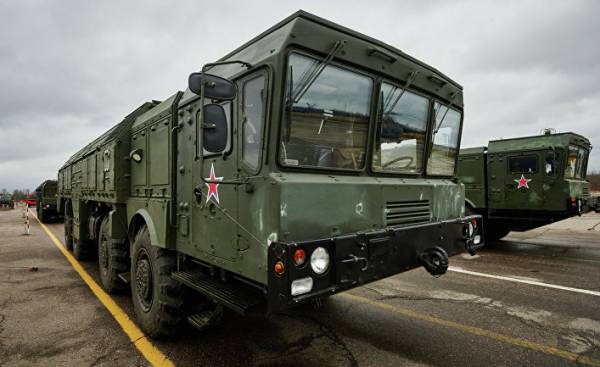
The aggravation of Russia’s relations with NATO gives Belarus hopes to receive from their partner in the Union state of modern weapons. Belarus in the future, may consider to buy Russia’s operational-tactical missile complexes (PTRC) “Iskander” and anti-aircraft missile system s-400. This was recently stated by the Belarusian Ambassador to Moscow Igor Petrishenko.
After all, the Chinese have helped with the replacement
Statement Petrishenko was a little surprising to military experts. As recently as on may 20-22, at the exhibition Milex-2017 in Minsk experts, international guests, media representatives and the General public was first shown the jet system of volley fire “Polonaise”, suitable for firing ammunition of several types. It is established with the help of China and last year entered service of the Belarusian army. At the same time was held presentation of new long-range missiles to the “Polonaise”, which, judging by the reaction of the expert community, surprised many experts.
Belarusian “Polonaise” may not be worse than the Russian “Iskander”
As noted by a Russian blog bmpd (he led the staff of the Center for analysis of strategies and technologies cast), this munition is likely to be a clone of Chinese missiles M20 (which, in turn, is an export version of the missile, the DF-12) belongs to the class of operational-tactical missiles with a maximum range of up to 280 km.
This parameter is subject to the restrictions of the international control regime missile technology, which prohibits the export of missiles with range more than 300 km range of the same DF-12, intended for the Chinese army, may exceed 400 km Due to the satellite navigation system circular error probable M20 (and, consequently, its Belarusian variant) of the target is about 30 m, the power of the warhead of TNT — about 500 kg.
The “Polonaise” with high probability, is the Belarusian version of the Chinese export universal missile complex GATTS (General Army Tactical Strike System), able to apply one launchers missiles types A100, A200, A300 and M20, as well as supersonic anti-ship missile CX-1. The release of the missiles for the “Polonaise” in Belarus is localized on the precision electromechanics plant in Dzerzhinsk.
Experts believe the cast, the de facto complex GATTS with missiles M20 is the functional counterpart and rival of the modern type of Russian PTRC “Iskander” or the American..
Potentially the Belarusian version of the M20 may have a range of 500 km, says the former chief of staff of the strategic Missile forces of Russia the General-Colonel Viktor Esin. But over that Minsk will not go, because it is a party to the Treaty on the elimination of intermediate range (the INF Treaty), along with Russia, USA, Ukraine and Kazakhstan. In violation of its provisions a country may be subject to quite serious sanctions.
Why did not work with Russia
So, the question arises: why Belarus “Iskander”, where everything has its own counterpart in the form of “Polonaise”? Especially that the birth of the Belarusian missile system was caused by the apparent reluctance of the Russian side to supply a nearby ally weapons of this type. Let me remind you that in the past the military-political leadership of Belarus has repeatedly stated the desire to get away from Russia, the export modification of the Iskander. Nevertheless, the supply of “Iskander” in our country did not take place.
According to some analysts, the root cause of a serious shortage of production capacity at the plant in Votkinsk, which produces missiles for this PTRC. However, to fully embrace this version of faith are hampered by the fact that the PTRC “Iskander-e” was transferred from Russia to the Armed forces of Armenia.
According to other experts, the case could Balk at the price, which requested Russia for their rockets. According to experts, the missile industry, the cost of the brigade “Iskander” in the 12 launchers is in the range of 200-300 million dollars. However, subtraction of this amount of cost of chassis manufactured for such PTRC Minsk wheel tractor plant, could seriously reduce the total purchase price for Belarus.
Making complex “Iskander” in the Belarusian army at the time was affected, and Alexander Lukashenko. Moreover, from the context of his statement of 23 April 2009 it was possible to understand that the allies have some differences on this issue: “We never asked the Russian “Iskander”. We will buy ourselves. But frankly, we could do it, if necessary, in addition to missiles, and missiles will buy”. It is possible that by this time the Belarusian President and had the idea of creating their own heavy multiple rocket launchers, which received later the name “Polonez”.
“Iskander” is still very cool
However, according to the statements of the Ambassador Petrishenko, the military-political leadership of Belarus, and now not abandoned the prospect of Iskander missiles on acceptable terms. Probably, the Belarusian side seduce high performance characteristics of the Russian missile system. In particular, for the first time managed to place on one self-propelled launcher, two rockets with a range of up to 500 km, And the Iskander can hit targets from several varieties of rockets. Has already been developed and accepted into service or is in the testing phase eight types of such missiles — as aeroballistic (range 500 km), and winged (with a range up to 2 thousand 600 km), among them are homing.
Aeroballistic missiles controlled throughout the entire flight, which is at an altitude of 50 km by using aerodynamic and gasdynamic rudders. Plane their trajectories are constantly changing. Particularly active maneuvers with an overload of 20 to 30g — made in the area of acceleration and approach to goal. To intercept such missiles, the missile must move along the path with the overload of two or three times more, and it is now almost impossible.
The application of Stealth technology (the use of spectorate, dropping the protruding elements of the design), as well as firing when approaching the target chaff, small-sized jammers, etc., further expands the possibility of “Iskander” in terms of overcoming ABOUT and makes it comparable only with Intercontinental ballistic missiles “Topol-M” and “YARS”.
Calculations show that no American missile system Patriot PAC-3 or a more advanced Standard SM-3 will not be able to provide reliable intercept missiles “Iskander”. If to speak about the amazing opportunities version of PTRC “Iskander-M” can destroy any object within a radius of 500 km with an accuracy of 2 m and a probability close to 100%.
One of the main features of the complex is the use of a set of special tools to maintain the desired flight path and aiming, which consists of Autonomous inertial control system, coupled with American and Russian global satellite navigation systems (GLONASS, NAVSTAR) and homing of various types.
And the “Iskander” can be used not only in pairing mode with external systems intelligence and control, when the feature information of the lesion is transmitted by satellite, reconnaissance aircraft or unmanned aerial vehicle. Targeting can be obtained with the special military intelligence machines of the soldier-artillery spotter or photograph of the area, which is right on the line of position through the scanner is entered in the onboard computer of the missile.
Direct targeting is small-sized homing head. Its ultra-sensitive sensor mode opto-electronic and (or) radar scanning in any state of the atmosphere probes the area in the terminal phase of flight, the reflected signal is converted into digital form and in the onboard computer checks the reference electronic map. This allows the missiles PTRC in the range of 280-500 km (depending on modifications) to hit a target, limited semimetals around.
They can be delivered to the target cluster (54 submunitions), penetrating, high-explosive and nuclear warheads. That allows you to hit small and area targets — firepower the enemy’s air and missile defense, aviation airfields, command posts, etc.
The “Iskander” is extremely mobile and stealthy, the probability of detecting even a means of space exploration is very low. Within one minute after the start of the set of missiles in the full radio silence this leaves the PTRC location.
What we can give
The main differences between the export version of the Iskander with the designation “a,” from the Russian “Iskander-M” are the lack of combat units with nuclear equipment, less accuracy and firing range, which is 280 km. in addition, in the export option on the launcher placed one missile, not two.
Belarus, in accordance with international agreements, can only claim this version of the “Iskander”. Not the fact, of course, that another attempt to obtain the coveted PTRC completed successful predecessors. Although, until recently, also few believed that Moscow will make good on delivery to Minsk of modern strike fighters su-30CM.







